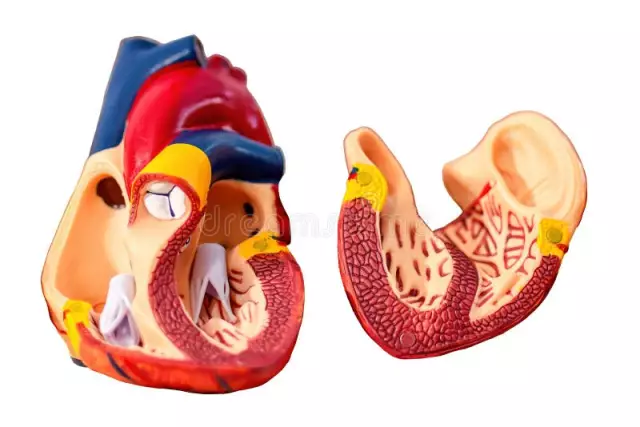- Author Curtis Blomfield [email protected].
- Public 2023-12-16 20:44.
- Last modified 2025-01-23 17:01.
The submandibular gland is a paired organ of the digestive system located in the oral cavity that produces saliva. The purpose of the latter is to moisten and disinfect the food bolus, as well as the primary hydrolysis of certain carbohydrates (for example, starch). This organ belongs to the group of three major salivary glands (along with the sublingual and parotid).

General characteristics of the organ
The submandibular gland (lat. glandula submandibularis) is a secretory organ with a complex alveolar-tubular structure, shaped like a spherical formation the size of a walnut and weighing about 15 grams (in newborns - 0.84).
The length of the gland in an adult is 3.5-4.5 cm, the width is 1.5-2.5, and the thickness is 1.2-2 cm. The structure of the organ is represented by lobes and lobules, between which are connective tissue layers containing nerves andblood vessels.
Glandula submandibularis refers to the salivary glands of mixed secretion, since the product secreted by it consists of two components: serous (contains a large amount of protein) and mucous.
Outside, the organ is covered with a thin connective tissue capsule formed by the superficial plate of the fascia of the neck. The connection between the gland and the shell is rather loose, so they are easy to separate from each other. The capsule contains the facial artery (and in some cases a vein).

The ducts of the submandibular salivary gland are divided into 3 types:
- intralobular;
- interlobular;
- interlobar.
These species successively pass into each other, gathering in a common outlet channel. The ducts of the first type depart from the lobules of the gland, or rather, from their terminal (or secretory) sections. The latter are divided into 2 types:
- serous - secrete a protein secret and have the same structure as similar structures of the parotid gland;
- mixed - consist of mucocytes and serocytes (each group of cells produces its own secret).
Mucocytes are located in the central zone of the terminal sections, and serocytes located on the periphery form the Jauzzi crescents.

Among the three major salivary glands, the submandibular gland ranks second in size and first in the amount of secreted substance. The work of this paired body accounts for 70% of the total volume allocated inoral cavity saliva at rest. With stimulated secretion, the parotid gland functions to a greater extent.
Topography
The gland is located deep under the lower jaw, hence its name. The place where the organ is located is called the submandibular triangle.

The surface of the gland is in contact:
- medial part - with hyoid-lingual and styloglossus muscles;
- front and back edges - with corresponding abdomens of the digastric muscle;
- lateral part - with the body of the lower jaw.
The outer side of the organ borders on the plate of the fascia of the neck and the skin.
Blood supply
The submandibular gland is supplied by three arteries:
- facial - passes to the organ through the capsule and serves as the main nutrient vessel;
- chin;
- linguistic.
Vessels with venous blood leaving the gland flow into the mental and facial veins.
Product
The network of excretory canals leaving the secretory parts of the organ unites into the duct of the submandibular gland, which originates from the front side of the organ and opens on the sublingual papilla, through which saliva enters the oral cavity.

The length of the outlet channel varies from 40 to 60 mm, and the inner diameter is 2-3 mm in an arbitrary section and 1 mm at the mouth. The duct is most often straight (in rare cases it hasarched or S-shaped).
Inflammatory process
The most common pathology of the salivary glands is inflammation or, scientifically, sialadenitis. Due to its location in the oral cavity, this disease is most characteristic of the parotid gland, but also occurs in the submandibular gland. Damage to the latter is relatively rare.

Inflammation of the submandibular gland most often has an infectious nature of exogenous (from the oral cavity) or endogenous nature. In the latter case, the pathogen enters the gland from the body itself. There are 3 routes for this infection:
- hematogenous (through the blood);
- lymphogenic (through lymph);
- contact (through tissues adjacent to the gland).
Most often, infection occurs exogenously, in which the entrance gate for the pathogen is the mouth of the gland duct. This can be facilitated by food particles entering the excretory canal.
Inflammation can be caused by:
- bacteria (oral microflora, streptococci and staphylococci);
- Epstein-Barr, herpes, influenza, Coxsackie, mumps, as well as cytomegalovirus, some orthomyxoviruses and paramyxoviruses;
- fungi (much less common);
- protozoa (pale treponema) - typical for specific cases.
The development of sialadenitis of the submandibular gland can be facilitated by weakened immunity, surgical operationsin the oral cavity, as well as diseases of the maxillofacial region and respiratory pathology (tracheitis, pharyngitis, pneumonia, tonsillitis, etc.).
Classification of sialadenitis
By the nature of the clinical course, inflammation of the submandibular gland can be acute and chronic. The latter has three forms:
- parenchymal (affects the parenchyma of the organ);
- interstitial (connective tissues become inflamed);
- with duct involvement.
Inflammatory disease of the submandibular gland, accompanied by damage to the ducts, is called chronic sialadochitis.
Clinical course and symptoms
In acute sialadenitis, the following pathological processes may occur in the submandibular gland:
- edema;
- increase in volume and compaction of organ tissues;
- infiltration;
- pus formation;
- tissue necrosis followed by scarring;
- reducing the amount of saliva produced (hyposalivation).
Inflammation is accompanied by pain in the affected organ, dry mouth, general deterioration of well-being, as well as standard signs of intoxication (chills, weakness, fever, fatigue).
Chronic sialaiditis is most often not accompanied by pain. During the period of exacerbation of this pathology, the patient may experience salivary colic. With a long chronic course, reactive-dystrophic changes often develop in the gland.






